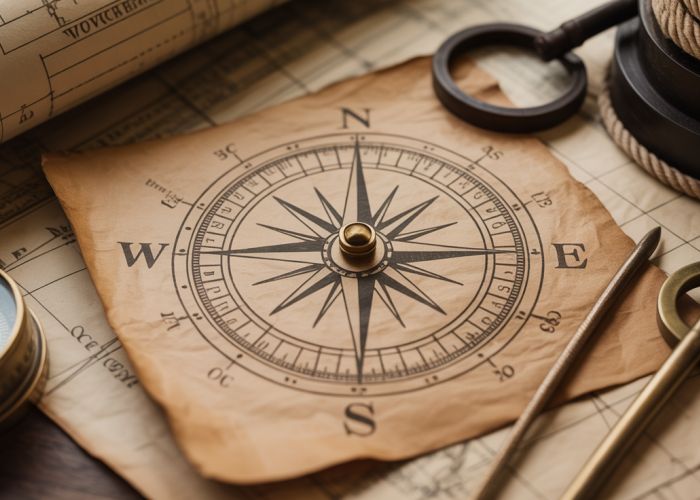The direction compass rose, a foundational tool in navigation, presents a visual representation of cardinal directions. Early cartographers, vital to organizations like the National Geographic Society, meticulously crafted these roses, illustrating directional relationships. These relationships are crucial for using tools like the sextant, essential for celestial navigation. This complete user’s guide aims to demystify the direction compass rose, offering insights utilized even by modern explorers following in the footsteps of figures like Robert Peary.

Crafting the Ultimate "Direction Compass Rose" User Guide: A Layout Blueprint
Creating a comprehensive guide on the "direction compass rose" requires a structured approach to ensure clarity and ease of understanding for the reader. The following layout is designed to deliver information logically and effectively.
1. Introduction: Setting the Stage
- Purpose: Briefly explain the purpose of the guide: to provide a complete understanding of the direction compass rose.
- Target Audience: Mention who the guide is for (e.g., students, hikers, navigators, map enthusiasts).
- What is a Direction Compass Rose? This should be a clear, concise definition. Consider including a visual aid (image or diagram) here. Example: "A direction compass rose, often simply called a compass rose, is a visual element found on maps and charts that indicates the cardinal directions (North, South, East, West) and sometimes intermediate directions."
2. History and Evolution of the Compass Rose
- Early Origins: Trace the historical roots of the compass rose, starting from its early forms. Describe how early compass roses may have looked.
- Medieval Development: Discuss the evolution of the compass rose during the Middle Ages and the Renaissance, highlighting key changes in design and functionality.
- Influence of maritime exploration.
- Introduction of the fleur-de-lis.
- Modern Usage: Explain how the compass rose is used today in cartography, navigation, and other fields.
3. Anatomy of a Direction Compass Rose: Deconstructing the Design
-
Cardinal Directions: Clearly identify and explain the four cardinal directions (North, South, East, West).
-
Ordinal Directions: Describe the ordinal directions (Northeast, Southeast, Southwest, Northwest).
-
Intercardinal Directions: Expand upon the above, introducing intercardinal directions. Use a table to show relationships:
Direction Abbreviation Degrees North N 0° Northeast NE 45° East E 90° Southeast SE 135° South S 180° Southwest SW 225° West W 270° Northwest NW 315° -
Degree Markings: Explain the purpose and significance of degree markings on a compass rose.
-
Wind Indicators (Optional): If applicable, explain the significance of any wind indicators or historical symbols present on the rose.
4. Interpreting and Using the Direction Compass Rose
- Finding True North vs. Magnetic North: Explain the difference between True North and Magnetic North and how to account for magnetic declination.
- Explain what magnetic declination is.
- How declination is represented on maps.
- Determining Directions on a Map: Provide step-by-step instructions on how to use the compass rose to determine directions on a map.
- Using a protractor.
- Estimating directions visually.
- Navigation Applications: Discuss practical applications of the compass rose in navigation, such as route planning and orientation.
- Understanding Grid North: In contexts using grid systems (like military maps), address the concept of Grid North and its relationship to True North and Magnetic North.
5. Variations and Types of Compass Roses
- Historical Variations: Showcase different historical designs of compass roses, highlighting their unique features and cultural significance.
- Modern Styles: Illustrate various modern compass rose designs used in contemporary maps and charts.
- Digital Compass Roses: Describe the digital representation of compass roses in Geographic Information Systems (GIS) and online mapping platforms.
6. Practical Exercises: Putting Knowledge to the Test
- Direction Finding Scenarios: Present a series of exercises or scenarios where readers can practice using the compass rose to determine directions on a map.
- Magnetic Declination Problems: Include problems involving magnetic declination to challenge readers and reinforce their understanding.
- Map Orientation Activities: Suggest activities where readers can use a map and compass rose to orient themselves in their surroundings. For example:
- Find a local park.
- Download a map of the park.
- Use the compass rose on the map to identify the direction of a specific landmark from your current position.
Direction Compass Rose: Frequently Asked Questions
Here are some common questions about direction compass roses and how to use them effectively.
What is the main purpose of a direction compass rose?
The primary function of a direction compass rose is to visually represent the cardinal directions (North, South, East, West) and intermediate directions (Northeast, Southeast, Southwest, Northwest). It aids in orientation and determining headings on maps, nautical charts, and other navigational tools. The direction compass rose simplifies understanding directional relationships.
How does a magnetic compass interact with a direction compass rose?
A magnetic compass indicates magnetic north. To use a direction compass rose on a map accurately, you must account for magnetic declination – the angular difference between true north (geographic north) and magnetic north. This adjustment ensures your bearings are true relative to the map’s representation.
Are all direction compass roses the same in design?
While the fundamental principles remain constant, direction compass roses can vary in design. Some are simple, displaying only the main cardinal directions. Others are more complex, including finer directional increments and ornamentation. Regardless of the aesthetics, the core function of indicating directions remains.
Can a direction compass rose be used without a map?
Yes, a direction compass rose can be used even without a map. For instance, many smartphones and GPS devices feature a digital direction compass rose, allowing you to determine your current heading relative to the cardinal directions in real-time, aiding in general orientation and direction finding even in unfamiliar environments.
So, whether you’re planning your next great adventure or just brushing up on your geography skills, we hope this guide to the direction compass rose has been helpful! Happy travels!